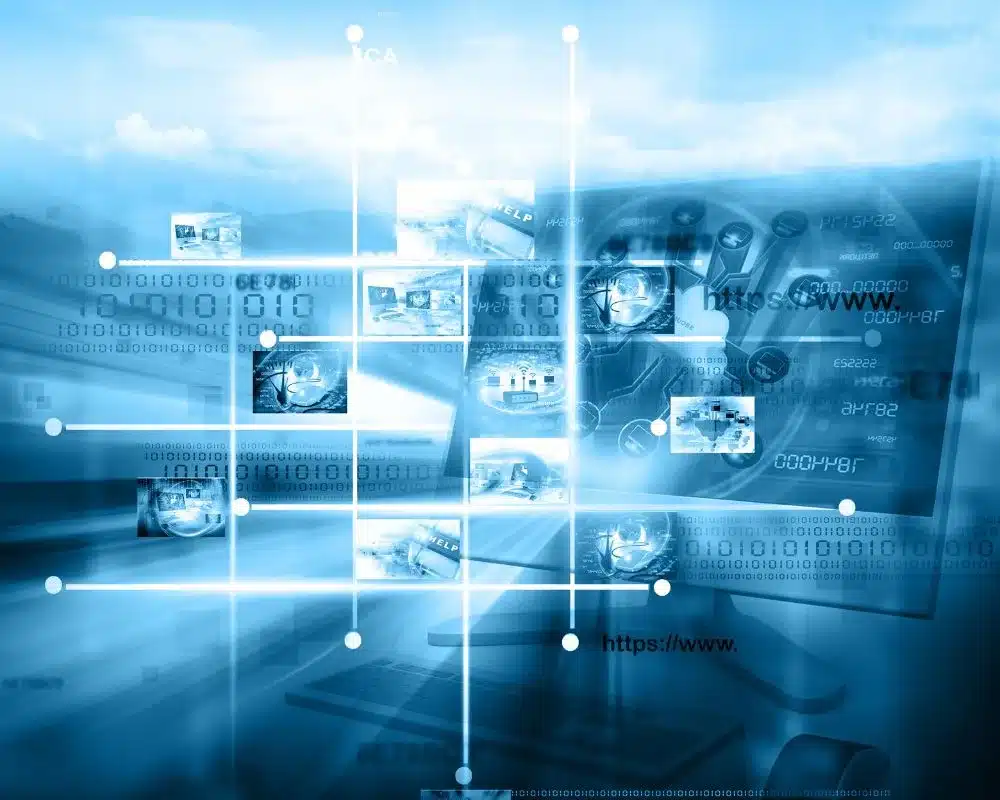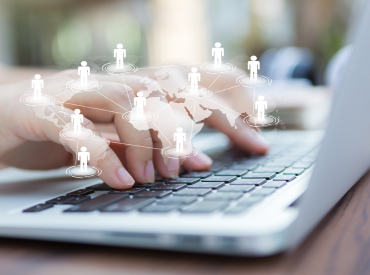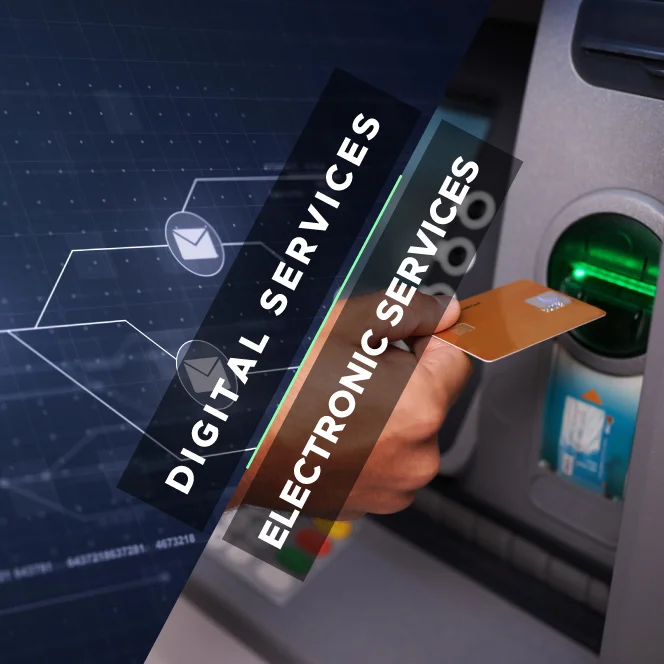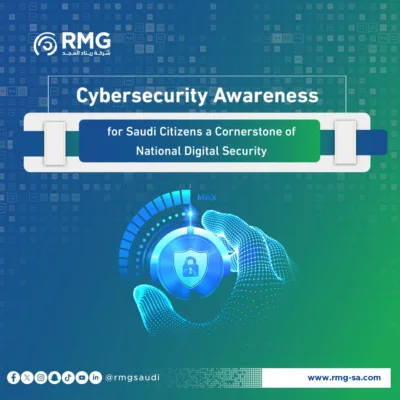Blog Body
Electronic and digital services are increasing in our time, as they provide many advantages to institutions and entities in improving service quality and reducing errors.
But is there a difference between “electronic services” and “digital services”?
Yes, we will recognise differences in this article.
The beginning
What are electronic services?
Electronic services refer to any service provided, managed or accessed through electronic means. This includes services that use analog or digital technology, including examples of electronic services: television, radio and telephone (analogue and digital).
- Examples of electronic services include:
- Communication services such as landlines, mobile phones, and fax machines.
- Television and radio broadcasting services.
- Automated Teller Services (ATM) for Banking Transactions
- Security systems such as surveillance cameras and alarm systems.

Some types of electronic services:
A wide range of applications and systems that use electronic devices, systems, or networks for communications, transactions, or data storage include some types of services:
- Communication services:
Prof Landlines
- Cell phones
- Fax machines
Dr. VoIP (Voice over Internet Protocol) services, such as Skype
- Broadcasting services:
Prof Television broadcasting (analogue and digital)
- Radio Broadcasting (AM, FM, and Satellite)
- Financial services:
Prof Automated Teller Services (ATM)
- Electronic Money Transfer Systems (EFT)
- Point of Sale (POS) devices for card payments
Internet services:
- Prof Internet Service Providers (ISPs)
- E-mail services
- Web hosting services
Dr. Cloud storage and computing services
- Security and surveillance systems:
Prof Surveillance cameras (CCTV)
- Alarm systems
- Access control systems (e.g., electronic door locks and biometric scanners)
- Transport services:
Prof Electronic ticketing systems for public transport
- GPS navigation systems
- Traffic control systems (such as traffic lights and electronic road signs)
- Health and medical services:
Prof Electronic Medical Records (EMRs)
- Telemedicine services
- Remote patient monitoring systems
- Utility services:
Prof Smart grid systems for electricity distribution
- Remote metre reading systems for water, gas or electricity
- Recreational services:
Prof Video game consoles
- E-books (e-books) and readers
- Audio and video playback devices (e.g., CD/DVD/Blu-ray players, MP3 players)
Benefits of electronic services
Electronic services provide many benefits, including:
Convenience and ease: Users can access electronic services anytime, anywhere, saving time and effort and making it easier to transact.
Cost savings: The electronic service saves administrative and operational costs, and reduces the need for employees, offices, hardware and software, saving money and time.
Increasing efficiency and productivity: E-services improve efficiency and productivity, allowing faster and more accurate work, and facilitating coordination and cooperation between employees and government and private agencies.
Error reduction: Electronic services minimise administrative and operational errors, giving users an opportunity to verify and correct data and information before sending them.
Let’s see now
What are digital services?
Digital service refers in particular to services that use digital technology, meaning that information is stored, transmitted, and processed in the form of a sequence of binary numbers (0s and 1s) Digital services take advantage of the Internet, cloud computing and other advanced technologies to provide services such as online banking, e-commerce, broadcasting and social media.
Digital services also refer to services that specifically use digital technology, which include data representation and processing in a binary format (0 and 1), and these services are often Internet-based or rely on computer networks to deliver.

Examples of digital services include:
- Banking and online financial transactions.
- E-commerce sites like Amazon and eBay.
- Streaming services like Netflix, Spotify, and YouTube.
- Digital communication platforms such as email, messaging apps (such as WhatsApp), and social media (such as Facebook and Twitter).
- Some types of digital services:
Some examples of digital services available today.
It is important to note that the digital landscape is constantly evolving, and that new services and platforms continue to emerge as technology advances.
- Online communication platforms:
Prof Email services (such as Gmail and Outlook)
- Instant messaging apps (like WhatsApp and Telegram)
- Social media platforms (such as Facebook, Twitter, Instagram)
Dr. Video conferencing tools (such as Zoom and Microsoft Teams)
E-commerce and online marketplaces:
Prof Online retail stores (such as Amazon and eBay)
- Digital payment services (such as PayPal and Stripe)
- Online auction platforms (e.g., eBay)
Dr. Online Classifieds (e.g., Craigslist, OLX)
- Digital content platforms:
Prof Streaming services (such as Netflix, Spotify, and YouTube)
- News and online publishing platforms (e.g., Medium, WordPress)
- E-learning platforms and MOOCs (e.g., Coursera and Udemy)
Dr. Online libraries and e-book services (e.g., Project Gutenberg and Kindle Store)
- Online Financial Services:
Prof Online banking and bill payment
- Mobile wallets and cryptocurrencies (such as Apple Pay and Bitcoin)
- Investment and trading platforms (e.g. Robinhood and E* TRADE)
Dr. Digital isurance services (e.g., Lemonade and Metromile)
- Cloud computing and storage services:
Prof Infrastructure as a Service (IaaS) (e.g., Amazon Web Services, Microsoft Azure)
- Platform as a Service (PaaS) (e.g., Google App Engine, Heroku)
- Software as a Service (SaaS) (e.g., Salesforce, Google Workspace)
- Online collaboration and productivity tools:
Prof Document and file sharing services (such as Google Drive and Dropbox)
- Project management tools (e.g. Trello and Asana)
- Online office groups (such as Microsoft Office 365 and Google Workspace)
- Digital marketing and advertising services:
Prof Search Engine Optimisation (SEO) and Marketing Services (SEM)
- Social media marketing services
- Email marketing services (e.g. Mailchimp and Constant Contact)
Dr. Online advertising platforms (such as Google Ads and Facebook Ads)
Digital health services:
Prof Telemedicine and telehealth platforms
- Schedule medical appointments online
- Health and fitness tracking apps (like MyFitnessPal and Fitbit)
Online gaming and virtual reality services:
Prof Online multiplayer games (like World of Warcraft and Fortnite)
- Mobile gaming apps (like Candy Crush Saga and Pokémon GO)
- Virtual reality platforms and experiences (such as Oculus Rift and HTC Vive)
Digital services benefit:
Digital services provide many benefits, including:
Convenience and convenience: Digital Services allows users to access services and information easily, anytime, anywhere, saving time and effort and making it easier to access the information and services they need.
Improving the customer experience: Digital services enable organisations to improve the customer experience, as they can access products and services, conduct transactions easily, anytime, anywhere, and provide personalised and personalised services that suit their needs.
Error reduction: Digital services minimise administrative and operational errors, giving users the opportunity to verify and correct data and information before sending them.
Effective communication: Digital services enable effective and instant communication between users, organisations and governments, where you can inquire and get answers quickly and effectively.
Conclusion:
Electronic services and digital services are similar in that they use electronic technologies to provide services to users. However, there is a difference between an electronic service and a digital service in the way they are provided. This difference is in how they are communicated to users.
Renad Almagd Information Technology Company (RMG) also offers electronic and digital services. We welcome inquiries and consultations.


























